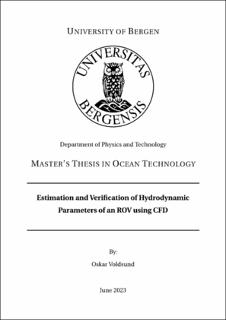| dc.description.abstract | The hydrodynamic added mass and damping of a Remotely Operated Vehicle (ROV) are estimated using Computational Fluid Dynamics (CFD) based on OpenFOAM. The estimated hydrodynamic parameters are verified with recorded data from an operating ROV at Snorre B (SNB). Then, the added mass and damping are adjusted to assess if a more accurate fit with the recorded data can be obtained. The ROV under investigation is the Merlin UCV, a work-class ROV. The UCV is first simplified to perform CFD. Two simplified versions are made, and the thin side plates are included in the more complex version. Two mesh convergence studies are conducted to verify the mesh and the computational domain. The Reynolds number is set to be $2.25 \times 10^6$. Numerical simulation based on Steady- and Unsteady-Reynolds-Averaged Navier–Stokes combined with the k-$\omega$ Shear Stress Transport (SST) turbulence model are performed to obtain the hydrodynamic parameters. By studying the influence of the side plates, it is found that the drag increases considerably when the plates are directly exposed to the flow. When there is a constant flow in sway, the value of $C_d$ is 1.4682 when the side plates are not considered. However, when side plates are introduced, the value of $C_d$ increases by 15 \% to 1.6880. Three different experiments are recreated numerically to find the added mass and damping in all Degrees Of Freedom (DOF) as a result of respective acceleration and constant velocity in the corresponding direction. The first numerical simulation is the towing tank test conducted to find the damping in the translational directions. Steady-Reynolds-Averaged Navier–Stokes (RANS) is used, and a constant velocity in the applicable directions are implemented. Then, rotating arm simulations are conducted to find the damping in the rotational directions. A similar procedure is used for the towing tank simulations, but a constant angular velocity is implemented. Planar Motion Mechanism (PMM) simulations are performed to obtain the added mass and inertia in all 6 DOF. Oscillatory linear and angular movements are executed to find the added mass and inertia in the translational and rotational directions. Since the movement is oscillatory, Unsteady-Reynolds-Averaged Navier–Stokes (URANS) is used to capture the time-varying flow. Furthermore, the numerical model used to estimate hydrodynamic parameters is validated by being compared to recorded data of an operational ROV at SNB. The recorded data were logged using the SPRINT, consisting of linear and angular position and velocity. A simulator code built on the classical equations of motion is made to simulate the movement data. Moreover, the CFD estimated added mass and damping are implemented in the equations. In the present study, the simulated movement of the ROV is later fitted with the recorded data. The fit between the recorded and simulated movement is satisfactory using the CFD estimated parameters. The added mass and damping are then adjusted, and an improved fit with the recorded data is achievable. Therefore, the conclusion is to adjust the hydrodynamic parameters if recorded data is available. This method is more efficient than CFD and gives more accurate results. However, if recorded data is unavailable, CFD can provide an efficient method to accurately predict the damping and added mass. | |
